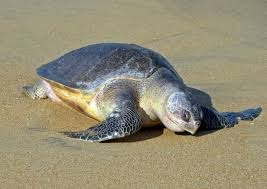Important Facts For Prelims
Olive Ridley Turtle
- 23 Mar 2020
- 2 min read
Why in News
- Recently, mass nesting of Olive Ridley Turtles started at Odisha’s Rushikulya rookery coast.
- The Rushikulya rookery on the coast of Odisha in India is the largest mass nesting site for the Olive-ridley, followed by the coasts of Mexico and Costa Rica.
Key Points
- Features: The Olive ridley turtles are the smallest and most abundant of all sea turtles found in the world.
- These turtles are carnivores and get their name from their olive colored carapace.
- Habitat: They are found in warm waters of the Pacific, Atlantic and Indian oceans.
- Migration: They migrate thousands of kilometers between feeding and mating grounds in the course of a year.
- Arribada (Mass Nesting): They are best known for their unique mass nesting called Arribada, where thousands of females come together on the same beach to lay eggs.
- They lay their eggs over a period of five to seven days in conical nests about one and a half feet deep which they dig with their hind flippers.
- Threats: They are extensively poached for their meat, shell and leather, and their eggs. However, the most severe threat they face is the accidental killing through entanglement in trawl nets and gill nets due to uncontrolled fishing during their mating season around nesting beaches.
- Protection Status and Steps Taken: The species is recognized as Vulnerable by the IUCN Red list, they are also protected under CITES Appendix I. They are also listed on Schedule – I of the Indian Wildlife (Protection) Act, 1972.
- To reduce accidental killing in India, the Orissa government has made it mandatory for trawls to use Turtle Excluder Devices (TEDs), a net specially designed with an exit cover which allows the turtles to escape while retaining the catch.






